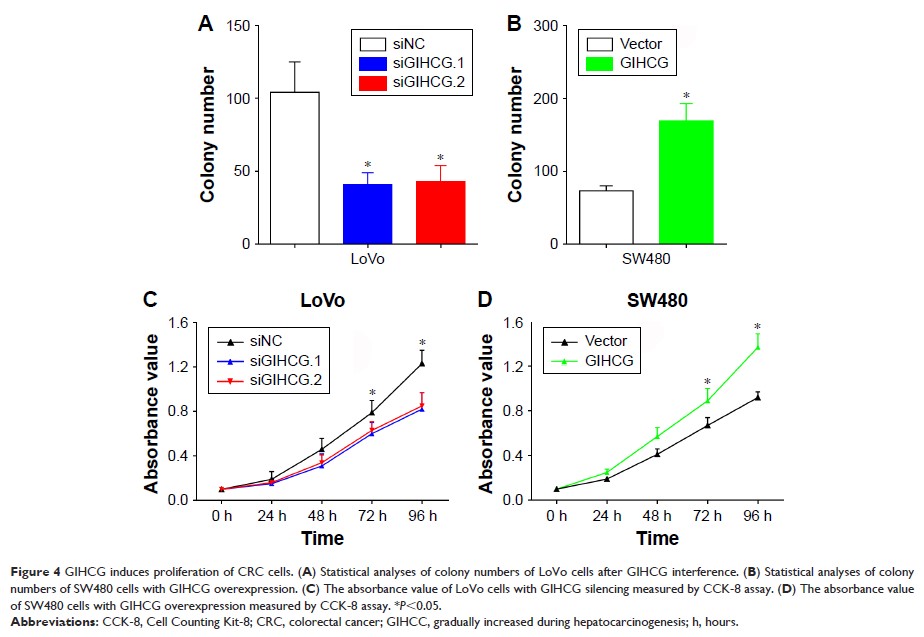108605
论文已发表
注册即可获取德孚的最新动态
IF 收录期刊
- 3.4 Breast Cancer (Dove Med Press)
- 3.2 Clin Epidemiol
- 2.6 Cancer Manag Res
- 2.9 Infect Drug Resist
- 3.7 Clin Interv Aging
- 5.1 Drug Des Dev Ther
- 3.1 Int J Chronic Obstr
- 6.6 Int J Nanomed
- 2.6 Int J Women's Health
- 2.9 Neuropsych Dis Treat
- 2.8 OncoTargets Ther
- 2.0 Patient Prefer Adher
- 2.2 Ther Clin Risk Manag
- 2.5 J Pain Res
- 3.0 Diabet Metab Synd Ob
- 3.2 Psychol Res Behav Ma
- 3.4 Nat Sci Sleep
- 1.8 Pharmgenomics Pers Med
- 2.0 Risk Manag Healthc Policy
- 4.1 J Inflamm Res
- 2.0 Int J Gen Med
- 3.4 J Hepatocell Carcinoma
- 3.0 J Asthma Allergy
- 2.2 Clin Cosmet Investig Dermatol
- 2.4 J Multidiscip Healthc

长非编码 RNA GIHCG 诱导癌症进展和化学抗性并可显示结肠直肠癌的预后不良
Authors Jiang X, Li Q, Zhang S, Song C, Zheng P
Received 26 October 2018
Accepted for publication 20 December 2018
Published 7 February 2019 Volume 2019:12 Pages 1059—1070
DOI https://doi.org/10.2147/OTT.S192290
Checked for plagiarism Yes
Review by Single-blind
Peer reviewers approved by Dr Andrew Yee
Peer reviewer comments 2
Editor who approved publication: Dr Tohru Yamada
Background: Colorectal cancer (CRC) is one of the
leading causes of cancer-related death worldwide, however, the mechanisms of
CRC progression remain obscure. The present study investigated the clinical
significance and functional role of long noncoding RNA (lncRNA) GIHCG in CRC.
Methods: Expression
of GIHCG was detected by quantitative real time polymerase chain reaction
(qRT-PCR) in seven CRC cell lines and 110 CRC tissues. Comparison of
clinicopathological characteristics in the high GIHCG expression group and the
low GIHCG expression group was performed. The overall survival (OS) and
progression-free survival (PFS) of the patients were depicted with Kaplan-Meier
test and compared with Log-rank test. Univariate and multivariate analyses were
carried out to detect the risk factors for poor OS and PFS. In addition,
expression of GIHCG was silenced with siRNAs in LoVo cells and overexpressed
with pcDNA3.1-GIHCG vector in SW480 cells, respectively. And the Transwell
assay, Matrigel assay, colony formation assay and Cell Counting Kit-8 assay
(CCK-8) were performed to investigate the role of GIHCG in the migration,
invasion and proliferation of CRC cells. Besides, the role of GIHCG in
chemoresistance was also detected.
Results: GIHCG
was overexpressed in seven CRC cell lines and 110 CRC tissues. High GIHCG
expression was correlated with lymphovascular invasion, lymph node metastasis,
distant metastasis and advanced TNM stages. Moreover, patients with high GIHCG
expression had much poorer OS and PFS rates. Besides, high GIHCG expression was
identified as an independent risk factor for poor OS and PFS. The Transwell
assay and the Matrigel assay discovered that GIHCG deficiency inhibited cell
migration and invasion, while ectopic expression of GIHCG promoted migration
and invasion. Besides, the colony formation assay and the CCK-8 assay verified
that GIHCG increased cell proliferation ability. By establishing 5-fluorouracil
(5-FU) and Oxaliplatin (Oxa)-resistant LoVo cells and SW480 cells, we found
chemoresistant CRC cells had much higher expression levels of GIHCG. Also,
GIHCG facilitated cell survival under 5-FU or Oxa treatment. Furthermore,
silencing of GIHCG notably reduced the improved cell survival rates of 5-FU or
Oxa-resistant LoVo cells compared with control cells.
Conclusion: GIHCG
contributes to cancer progression and chemoresistance and indicates poor
prognosis in CRC. GIHCG may be a promising prognostic biomarker and therapeutic
target in CRC.
Keywords: lncRNA,
migration, invasion, proliferation, drug-resistance
